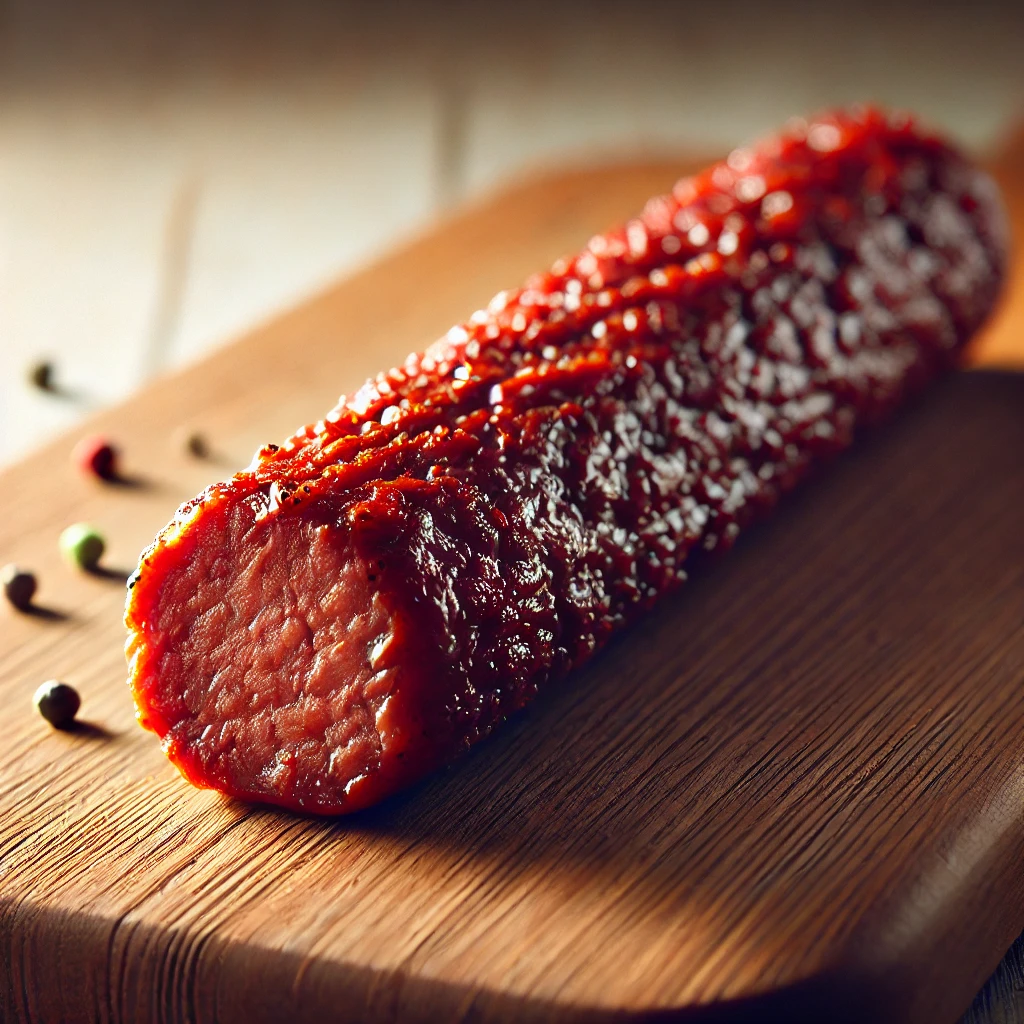Have you ever wondered what’s really inside those meat sticks you grab at the gas station? We’re here to uncover the mystery behind this popular snack. Meat sticks are made from ground meat, spices, and preservatives.

These protein-packed treats come in many flavors and brands. They’re a go-to choice for busy people looking for a quick energy boost. But are they as healthy as they claim to be?
We’ll explore the ingredients that make up meat sticks and how they compare to other snack options. Join us as we take a closer look at this convenient food and what it means for your diet.
Understanding Meat Sticks
Meat sticks are tasty snacks packed with protein. Let’s explore what goes into these popular treats and how they stack up nutritionally.
Composition and Ingredients
Meat sticks are made from ground meat mixed with spices and stuffed into thin casings. The main ingredient is usually beef, pork, or a mix of both. We add salt, sugar, and spices like garlic, paprika, and black pepper for flavor.
Some brands use natural casings made from animal intestines. Others use collagen casings, which are edible and made from beef hide. The meat mixture is stuffed into these casings and then smoked or dried.
Most meat sticks also contain preservatives to keep them shelf-stable. These might include sodium nitrite or lactic acid starter culture.
Types of Meat Used
Beef is the most common meat in meat sticks. Many brands use 100% beef, which gives a rich flavor. Some mix beef with pork for a softer texture.
Turkey and chicken meat sticks are becoming more popular as lower-fat options. We’ve even seen exotic meats like bison or elk used in specialty brands.
The quality of meat can vary. Some use whole muscle meat, while others use trimmings or lower-grade cuts. High-end brands might use grass-fed beef or organic meats.
Nutritional Profile
Meat sticks are high in protein, which helps keep us full. A typical 1-ounce stick has about 6-7 grams of protein. They’re also rich in zinc and iron, which are good for our bodies.
On the flip side, meat sticks can be high in fat and sodium. One stick might have:
- 100-150 calories
- 8-12 grams of fat
- 400-500 mg of sodium
They’re low in carbs, with 1-2 grams per stick. Some have added sugar for flavor.
Meat sticks don’t have fiber or many vitamins. They’re not a complete meal, but can be a quick protein boost when we’re on the go.
Manufacturing Process

Meat sticks go through several steps to become the tasty snacks we love. Let’s look at how they’re made, from grinding the meat to packaging the final product.
Grinding and Mixing
We start by grinding fresh meat into small pieces. This makes it easier to mix in spices and seasonings. We use a big grinder that can handle lots of meat at once.
Next, we add salt, spices, and other flavors. These give meat sticks their yummy taste. We mix everything well so the flavors spread evenly. Some common spices are garlic, pepper, and paprika.
The mixture is then put in a big bowl and mixed some more. This helps the meat stick together better.
Stuffing and Casing
Now it’s time to stuff the meat into casings. We use a machine called a stuffer for this job. It pushes the meat mix into long, thin tubes.
The casings can be made from different things. Some are natural, like cleaned animal intestines. Others are man-made, like cellulose or collagen.
The meat-filled casings are twisted or tied to make individual sticks. These are usually about 6 inches long.
Smoking and Drying
Smoking gives meat sticks more flavor and helps keep them fresh. We hang the sticks in a special smoker. The smoke comes from burning wood chips.
After smoking, we dry the sticks. This takes out extra moisture. It makes the sticks last longer without going bad.
The drying process can take a few days. We control the temperature and humidity carefully. This helps the sticks dry evenly and safely.
Packaging
When the meat sticks are ready, we package them. We often use plastic wrappers to keep them fresh. Some sticks are sold one by one. Others come in packs of many sticks.
We put labels on the packages. These tell what’s in the sticks and how long they’ll last. Meat sticks can stay good for a long time if they’re packaged right.
The packaged sticks are then boxed up. They’re sent to stores where people can buy them as a tasty, ready-to-eat snack.
Flavors and Seasonings

Meat sticks come in many tasty varieties. Makers use different spices and seasonings to create unique flavors that people love.
Classic and Gourmet Flavors
We can find meat sticks in both classic and fancy flavors. Original is a popular choice that lets the meat’s taste shine. Peppered sticks have a nice kick from black pepper. Teriyaki adds a sweet and salty Asian twist. Some brands offer BBQ, honey, or even spicy jalapeno flavors. Gourmet options might include smokehouse maple or cracked black pepper. There’s truly a flavor for everyone!
Spices and Herbs
Spices and herbs play a big role in making meat sticks taste great. Garlic is often used to add depth. Paprika gives a mild, sweet pepper flavor. Other common spices include:
- Onion powder
- Coriander
- Mustard powder
- Red pepper flakes
Herbs like thyme or rosemary can add an earthy touch. Some makers use blends of many spices to create complex flavors. The mix of spices can vary based on the style or region the meat stick comes from.
Dietary Considerations

Meat sticks can fit into many eating plans. They’re often a good choice for people with specific food needs or goals. Let’s look at how they work for different diets.
Gluten-Free and Allergy Information
We’re happy to say that most meat sticks are gluten-free! This makes them a great snack for people who can’t eat gluten. But it’s always smart to check the label, just in case. Some brands might add things with gluten.
For those with food allergies, meat sticks can be a safe bet. They’re usually free from common allergens like nuts, dairy, and soy. But again, it’s best to read the package carefully. Some flavors might have allergens added.
Meat sticks are often made with just meat and spices. This simple mix is good news for many people with food sensitivities.
Paleo and Keto Options
Meat sticks are a hit with paleo and keto dieters! These diets focus on high protein and low carbs, which fits meat sticks perfectly.
For the paleo crowd, many meat sticks tick all the boxes. They’re made from animal protein and don’t have grains or processed foods. Look for sticks made with grass-fed meat for the best paleo option.
Keto fans love meat sticks too. They’re high in protein and fat but very low in carbs. This makes them a great keto snack. Some brands even add extra fat to make them more keto-friendly.
We’ve seen more paleo and keto-specific meat sticks pop up lately. These often use high-quality meats and avoid any non-approved ingredients.
Preservation and Shelf Life

Meat sticks stay fresh for a long time thanks to some smart storage tricks. Let’s look at how to keep them tasty and safe to eat.
Refrigeration and Freezing
We love keeping our meat sticks cold! Popping them in the fridge helps them last longer. The cool air slows down bacteria growth. For even longer storage, we can freeze them. Frozen meat sticks can stay good for months.
To freeze, we wrap them tightly in plastic or foil. This stops freezer burn. When we’re ready to eat, we just move them to the fridge to thaw. Easy peasy!
Shelf Life Considerations
Meat sticks can be shelf-stable too. This means they don’t need to be in the fridge right away. How do they do this? It’s all thanks to drying and salt.
Drying removes water that bacteria need to grow. Salt also helps keep the bad bugs away. Some meat sticks can last for weeks or even months at room temp if they’re sealed.
But once we open the package, it’s best to eat them soon. Or pop them in the fridge to make them last longer. Always check the “best by” date to be safe.
Practical Usage
Meat sticks offer a handy and tasty way to get protein on the go. They’re great for quick snacks and can even be part of meals.
Snacking and Meal Replacements
We love meat sticks as a go-to snack. They’re perfect for busy days when we need a quick energy boost. Toss a few in your bag for work, school, or outdoor activities. They don’t need refrigeration, so they’re super convenient.
Meat sticks can also work as a light meal replacement. When we’re in a rush, they provide protein to keep us full. Pair them with some fruit or veggies for a balanced mini-meal.
For health-conscious snackers, meat sticks are a good choice. They’re often lower in carbs than many other snacks. Plus, their protein helps curb hunger between meals.
Incorporating into Meals
Meat sticks aren’t just for snacking – we can use them in meals too! Here are some ideas:
• Slice them up for a quick pizza topping
• Chop and add to scrambled eggs
• Use as a flavorful addition to salads
For an easy appetizer, arrange sliced meat sticks on a charcuterie board. They pair well with cheeses and crackers.
Try using meat sticks in recipes that call for sausage. They can add a smoky flavor to pasta dishes or casseroles.
For a fun twist, wrap meat sticks in crescent roll dough and bake. It’s a tasty, protein-packed snack that kids and adults both enjoy.

